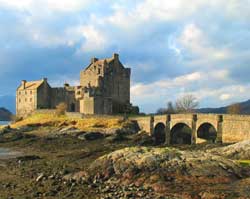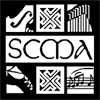

Eilean Donan, Scotland
NTIF 2012 Scottish Village
Scots, wha hae wi Wallace bled,
Scots, wham Bruce has aften led,
Welcome tae yer gory bed,
Or tae victorie.Robert Burns, 1793
Clans and Family Societies
The clan system which arose in Scotland around the 11th century was a complex society. The clan family was headed by a Chief. While many of the clansmen were blood relations others might be tenants of the clan lands. The clan also included those who married into the clan as well as other unrelated individuals and smaller families or clans (septs) who joined the larger clan for protection and support. A "sept" moved into a region or moved out of a region and changed allegiances. As a result some "septs" are allied with more than one clan family. The clan system was based on the economics of the times and functioned, for better or worse, much like a family business.
The word clan is from the Gaelic and means "children." Originally each clan was made up of the descendants of one man and his children. The clan names which are in use today have come down from the founds of the royal dynasties of the Picts, the Scots and the Vikings in the Highlands as well as the noble families of the Britons, Flemish, Normans, Angles, and Saxons in the Lowlands and Borders.
These royal dynasties are the ancestors of the Scots. Our family tree grew horizontally as well as vertically. While the king, queen, or heir apparent of a dynastic family was often married "across the water" to someone of comparable royal rank and the heir to a noble title was married "across country" to ensure peace or secure property, their other children generally married locally. The surname of the dynastic family spread slowly, but through intermarriage gradually everyone in the region was absorbed.
It is this brotherhood, beyond rank, sex, religion, success, or failure, which links the Scots together. We are all one interrelated family; the branches of the family are the family names, clan, and septs. As a result, all bearers of Scottish names share in the rich pageantry and experiences of our common ancestors.
Today clan family societies are generally formed for educational, literary, social, or beneficial purposes, to further friendships and share the heritage of the clan family to collect and preserve its relics and, in the case of some larger societies, to assist in the maintenance and acquisition of former clan territories in Scotland. Visit the clan area and meet your family.
The Scots and their descendants are extremely proud of their long and colorful history so while you are attending the NTIF, make it a point to visit the Clan area. You will have no problem finding them. Look for brightly colored flags, tartans and banners flying. You'll be as welcome as you can be and you will find many gracious and interested folks who will be more than happy to help you with any questions you might have. The Scottish Village is located at the east end of the Automobile Building across from the Urchin Street (children's) area.
I will not yield,
To kiss the ground before young Malcolm's feet,
And to be baited with the rabble's curse.
Though Birnam wood be come to Dunsinane,
And thou opposed, being of no woman born,
Yet I will try the last. Before my body
I throw my warlike shield. Lay on, Macduff,
And damn'd be him that first cries, 'Hold, enough!'"That Scottish Play!", William Shakespeare

